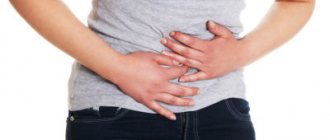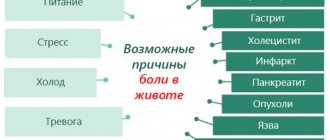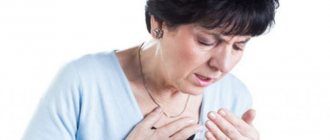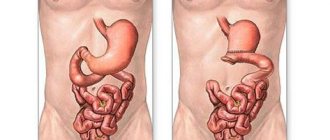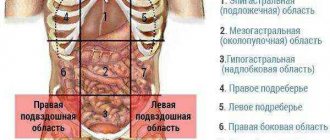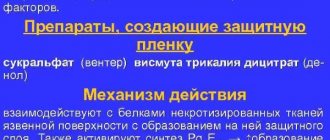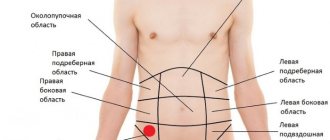The lower abdomen pulsates in women with gynecological diseases (inflammation of the appendages, suppuration of the ovary, rupture, cyst), and in men the cause may be the movement of a stone along the ureter, an inguinal hernia. Pain and throbbing in the umbilical region with a shift to the right and down is typical for appendicitis.
The feeling of a pulse beating in the abdomen in time with the contractions of the heart in men over 60 years of age, smokers and with high blood pressure requires urgent consultation with a doctor. This is important to rule out a very life-threatening abdominal aortic aneurysm. Diagnostics includes ultrasound, tomography, general tomography of the abdominal cavity. For aneurysm and tumor, suppuration, surgery is required; for other diseases, medications are most often used.
The stomach is pulsating: what does a person feel?
When complaining that the abdomen is throbbing, the patient can describe his sensations inside the abdominal cavity in the following words:
- stomach twitches;
- I feel a palpitation, a heartbeat near the navel;
- you can see how much your stomach is pulsating;
- there is a pulsation in the stomach;
- ticks, stomach pulsates in time with the heart;
- like a ball bouncing.
If such symptoms are present, the doctor asks clarifying questions about the time of onset, connection with food, physical activity, and whether the pulsation in the abdomen is constant or periodically appears and disappears. Then the patient reports on previous illnesses (history), after which an examination is carried out.
If the disease is serious, then patients usually describe the symptoms briefly; with functional and mental disorders (changes in the perception of sensations), the complaints are very numerous and completely varied, colorful.
Why did the pulsation appear in the lower abdomen?
Pulsation in the lower abdomen can be associated with inflammatory diseases; in women, the cause is most often gynecological diseases:
- adnexitis (inflammation of the appendages), tubo-ovarian abscess (suppuration in the fallopian tube and ovarian tissue);
- ovarian cyst and its complicated course (pedicle torsion);
- adhesive disease of the abdominal cavity after cesarean section, removal of fibroids or other pelvic surgery;
- uterine prolapse;
- endometriosis;
- tumor processes in the uterus, appendages;
- ectopic pregnancy;
- rupture of the ovary (apoplexy), fallopian tube.
In men, the lower abdomen twitches and pulsates when a stone moves through the ureter, appendicitis, or inguinal hernia. When the abdomen pulsates in the lower part of a girl who is sexually active, it is necessary to conduct a pregnancy test. During pregnancy, pulsation is not dangerous, if there is no pain or bleeding; if they are detected, an urgent examination by a gynecologist is required, since such symptoms are typical for a miscarriage.
Nervous tic: why it occurs and how to treat it. Delivery of contact lenses and glasses in Moscow and Russia
Every person experiences involuntary twitching of the eye muscles. This symptom may occur due to banal overwork. A nervous tic, if it occurs rarely, is not particularly dangerous. If this problem constantly bothers you, it is worth finding out its causes. Perhaps a nervous tic is a consequence of a severe disease of the central nervous system.
What is a nervous tic?
A nervous tic is a type of hyperkinesis - involuntary movement of one or more muscle groups. Twitching of muscle tissue occurs suddenly and also disappears unexpectedly.
Not all forms of hyperkinesis are characterized by pathology. Perhaps all people have encountered such a phenomenon as a nervous tic of the eye. In this case, we are talking about a transient or temporary nervous tic, which occurs in people of all ages.
At the same time, involuntary contractions of the eye muscles are the most common neurological problem in children aged 2 to 10 years.
Before moving on to considering the causes of nervous tics, it is necessary to delve a little deeper into the process of its occurrence in the human body.
The cerebral cortex contains many areas responsible for specific functions: speech, emotions, movements, thoughts, visual images. All nerve centers in the brain are closely intertwined.
The extrapyramidal system is located in the subcortical part of the brain. It is not part of the cortex, but is connected to it through nerve connections.
Together they form a single system responsible for functions such as:
- ensuring coordinated muscle movements;
- regulation of skeletal muscle tissue tone;
- maintaining body posture.
There are many types of nervous tics, but they are all associated with disturbances in the extrapyramidal system. A variety of factors can lead to its disorder.
Why does a nervous tic occur most often in the eye?
Nervous tics are vocal and motor, primary and secondary. Involuntary muscle twitching can occur on any part of the body, but most often it appears on the eye.
What is this connected with? The reasons lie in the anatomical features of the face and the area around the orbit. There are a lot of nerve endings and muscles near the eyes. The weakest muscles of the human body are located around the orbit.
In addition, the face most often displays emotional experiences.
Nervous tics in children: causes and symptoms
According to medical research, tics in one form or another occur in 30% of children. Most often it is observed at the age of 2-10 years. But it also occurs quite often later.
At the same time, boys have nervous tics three times more often than girls. Typically, this phenomenon is typical for the age when a child enters kindergarten or school.
These life moments are very important for him and cause a kind of fear, leading to a nervous eye tic. As a rule, it goes away on its own. But in some cases it may persist.
Then you need to find out its causes and begin treatment.
The child may not notice the tic. Even if someone draws his attention to the constant blinking, the child will not be able to prevent it. Most likely, contractions of the eye muscles will intensify and become even more frequent.
Nervous tics in a child can be primary or secondary. Primary becomes the result of a disruption of the nervous system. The causes of secondary nervous tics of the eye are the consequences of diseases of the central nervous system. But the most common causes of involuntary twitching of the eye muscles are:
- Emotional trauma. They cause severe fear in the child and lead to nervous disorders.
Typical emotional traumas include experiences of violence, conflicts in the family, and stress received in kindergarten or school. Much depends on the child’s temperament and the character that is still being formed.
Some children do not express fear and other internal negative emotions, which accumulate and subsequently come out in the form of tics.
- Overwork. It is caused by both great mental stress and lack of adequate physical activity. Play sports, even regular walks, help release emotions. Lack of activity leads to the accumulation of emotions and the appearance of tics.
- Heredity. The probability of inheriting a nervous tic is 50% if at least one parent suffers or suffered from this illness in childhood.
Psychologists note that parental education methods in some cases can be the cause of tics in children. Excessive categoricalness of adults, constant prohibitions, punishments in the absence of warm and lively communication are factors that can lead to great emotional stress.
Emotional stress can manifest itself as an eye tic. At the same time, excessive guardianship, accompanied by interrogations, an attempt to control every action of the child and protect him from all possible and hypothetical “dangers” can cause emotional failure. The likelihood that it will manifest itself in the form of eye twitching is quite high.
The listed causes of tics affect mainly psychological aspects, with the exception of the hereditary factor. However, tic can be a consequence of serious diseases - meningitis, encephalitis, atherosclerosis. Serious head injuries are another very common cause of tics.
Such factors also lead to nervous tics in adults, when emotional experiences do not affect a person as strongly as in childhood. In childhood, on the contrary, it is stress and other psychological factors that act as the main causes of nervous eye tics.
Other causes of nervous tics in adults
In adulthood, involuntary blinking and contractions of the muscles of the eyes and face are caused by:
- excessive strain on the eyes caused by prolonged work at the computer and reading books;
- injuries;
- pathologies of the central nervous system;
- depression, stress, neurosis;
- lack of vitamins in the body;
- vegetative-vascular dystonia;
- somatic diseases;
- side effects of medications.
Some doctors associate the appearance of tics with liver disease. In fact, this phenomenon is still being studied. Nervous system disorders are quite complex diseases that require an integrated approach to study. Now let's look at the symptoms and treatment of nervous tics.
Symptoms of eye tics
The symptoms of tic are very pronounced. Twitching of the eye muscles and frequent blinking are visible to the naked eye. They arise suddenly, and also suddenly the nervous tic goes away. At the same time, there is no system in the appearance and disappearance of involuntary muscle movements.
In this regard, they cause particular discomfort. A nervous tic may begin during an exam, work, or other important event. Because of this, the person worries even more, and the tic symptoms intensify. It often occurs during strong excitement, close attention from others, or danger.
Although for some people, tics appear during the rest period, when the body muscles are as relaxed as possible. The peculiarity of a child’s tic is that he may not pay attention to it. In adulthood, such phenomena are noticed immediately. The duration is also uncontrollable, as are the main symptoms of a nervous tic.
Twitching of the eye muscles can last for seconds or minutes. Sometimes this condition lasts for several days.
A nervous tic happens all the time - what to do?
If a nervous tic occurs constantly, you should go for examination to a doctor. There is no point in going to an ophthalmologist, since tic is not an ophthalmological disease.
First you need to visit a therapist who will give you a referral for tests, based on the results of which other studies will be prescribed.
In most cases, encephalography of the brain and ultrasound examination of the abdominal organs, especially the liver, are required.
The results of tests to determine the microelements missing in the body may be important for diagnosis.
Based on the results of the examination, treatment is prescribed. It consists in eliminating the main cause of the nervous tic, which is just a symptom.
Treatment of nervous tics
This disease is treated comprehensively using three methods: medications, special exercises and folk remedies.
Medicines, traditional medicine and exercises help to completely get rid of tics or eliminate them quickly every time they appear.
The most common medications prescribed for nervous tics are motherwort and valerian. They are sold in the form of tablets and infusions.
Such drugs are available without a prescription, but the instructions for use must be strictly followed, since these drugs in large quantities can cause fatigue and increased drowsiness.
Valerian and motherwort are taken in courses. They have a cumulative effect that is felt about a week after administration. This effect is the normalization of sleep and general calmness, and eye twitching occurs much less frequently when taking them.
Also, if there are problems in the functioning of the nervous system, it is recommended to take drugs containing magnesium and calcium, which are involved in the process of transmitting nerve impulses.
In rare cases, the doctor prescribes Botox injections, which gives elasticity to the eye muscles. Therefore, nervous twitching will be invisible to others.
This procedure is prescribed only to adults and helps eliminate only a cosmetic defect. Many people begin to have complexes about this, which does not contribute to treatment. In severe forms of the disease, when a nervous tic appears very often and greatly complicates a person’s life, courses of psychotherapy are prescribed.
Treatment of teak with folk remedies
Traditional medicine advises making compresses from herbs that have a calming effect.
Compresses made from tea, chamomile and nettle decoctions, and bay leaves are perfect for relieving fatigue and tension from the eyes.
A cold compress, as well as lotions made from melted honey, can reduce twitching. A wonderful relaxing effect comes from taking a bath with sea salt and various oils.
It is clear that a one-time use of compresses will not cure a nervous tic, much less the disease that provoked it. But it is possible to stabilize the emotional background in this way. This contributes greatly to healing.
Exercises to relieve symptoms of nervous tics
To quickly get rid of eye tics, you can start by blinking a little. Next, you need to open your eyes as wide as possible, then close your eyes tightly. This exercise should be repeated 10-15 times.
If tears appear while doing eye exercises, do not be alarmed. This reaction is normal. A light eye massage can also help get rid of twitching.
All these exercises are suitable for both adults and children.
Prevention of nervous tics
You can reduce the likelihood of developing a nervous tic by maintaining a healthy lifestyle. You need to exercise, eat right, take a break from work more often and be in the fresh air.
Giving up bad habits should be the first preventive measure. Proper organization of working time is another important step that every person should take.
Also, nervous tics rarely occur in people who follow a sleep and rest schedule.
We examined the main issues related to such an ailment as nervous tics: causes, symptoms, treatment in adults and children. In conclusion, it is worth noting that a nervous tic in itself is not dangerous.
It does not affect the functioning of the nervous system, much less other organs. However, a nervous tic can signal pathologies that require treatment.
Do not ignore this symptom.
Source: https://www.ochkov.net/informaciya/stati/nervnyj-tik-pochemu-voznikaet-i-kak-lechitsya.htm
Pulsation in the abdomen: causes of sensations in different places
It is not always possible to immediately suspect a disease based on the location of the pulsation in the abdomen, since in most patients the localization of sensations changes; it is more important to take into account the accompanying symptoms.
In the area of the stomach, navel
The area of the stomach is the epigastric angle (epigastric zone); if strong pulsation appears between it and the navel, it is necessary to exclude the most dangerous cause - an abdominal aortic aneurysm.
This is a protrusion of its wall, which is often accompanied only by pulsation. Abdominal pain is often absent or tolerable, but attacks similar to radiculitis and exacerbation of inflammation of the pancreas are also possible.
Men over 60 years of age are more often affected, 2/3 of them are smokers. When the diagnosis is made late, the aortic wall becomes thinner, which can lead to rupture during physical stress or even at rest. Severe internal bleeding occurs because the aorta has the highest blood pressure. Most die.
The cause of aneurysm in 90% of cases is atherosclerosis, less often it develops with:
- aortoarteritis,
- syphilis,
- tuberculosis,
- rheumatism,
- mycoplasma infection,
- salmonellosis,
- abdominal trauma.
There is also a risk with congenital weakness of the aortic wall. Provoking factors can be arterial hypertension and cough in chronic lung diseases.
To the right of the navel
Pulsation to the right of the navel is most often associated with intestinal diseases, where the small intestine and the ascending part of the large intestine (colon) are located. If the place where the pulse is felt is closer to the groin area, then this may be one of the first symptoms of appendicitis.
Suspicion of its development is confirmed by:
- pain in the epigastric and periumbilical region;
- movement of pain downwards, closer to the groin;
- pain increases with coughing and laughing, decreases when lying on your side with bent knees;
- nausea, vomiting;
- temperature rise to 37.2-37.5 degrees;
- rapid pulse;
- constipation or diarrhea.
Painless forms of appendicitis with abdominal throbbing or twitching sensations are typical in elderly patients with diabetes.
To the left of the navel
To the left of the navel and in the upper third, pulsation is a sign of inflammation of the pancreas (pancreatitis), intestines (colitis), flatulence, and dysbacteriosis.
Also in this area, a pulse can be felt in case of an abdominal aortic aneurysm or a tumor neoplasm (benign and malignant). Signs indicating an intestinal tumor may include:
- rumbling in the stomach;
- alternating diarrhea and constipation;
- the appearance of blood in the stool or a dark, tarry appearance;
- painful urge to have a bowel movement;
- general weakness;
- loss of weight and appetite.
Above the navel
Pulsation and pain above the navel are possible with exacerbation of duodenal ulcer. It is usually associated with eating (30-40 minutes after), hunger pain and night pain are also typical. An important feature of this area is that an atypical form of myocardial infarction can occur with a sensation of pulse beating and squeezing.
Patients usually report severe weakness, nausea, vomiting, and diarrhea. The skin is pale and covered in cold sweat. The difference between a heart attack and diseases of the digestive system is that eating does not affect your well-being in any way, and when moving it becomes worse; rest alleviates the condition.
In the intestines
If a patient complains of pulsation in the entire abdomen or describes a feeling of beating of a vessel against the background of lack of air, interruptions in heart function, or strong causeless fear, then this is typical of a panic attack.
Its distinctive features:
- general condition is normal, it is possible to talk and move;
- chills alternate with hot flashes;
- feelings of unreality of what is happening;
- paroxysmal course, when between panic attacks the symptoms completely disappear.
In a supine position
In a state of complete rest, in a supine position, before going to bed, pulsation in the abdomen is often one of the manifestations of senesthopathy - psychological sensations without diseases. This condition is part of the symptoms of depression or hypochondria (constant concern about health), neurosis, and mental disorders.
Senestopathies are characterized by many different symptoms that do not fit within the course of any known disease. Patients describe their feelings as emotional and very painful. As it progresses, new symptoms are added all the time and/or the pulsation moves to other parts of the body.
During pregnancy, especially in the later stages, pulsation in a supine position is normal. It appears due to compression of the abdominal aorta and inferior vena cava by the enlarged uterus. In the third trimester, women are recommended to rest only on their side, so as not to disrupt blood circulation in the body.
Preventive actions
To prevent discomfort in the stomach, people should take preventive measures that directly depend on the etiology of pulsation:
- If the cause of twitching is pathological processes, for example gastritis with high acidity, then patients should take drugs that slow down the process of hydrochloric acid production, for example, Gastal.
- If discomfort is accompanied by bloating, patients are advised to take Espumisan.
- If the cause of discomfort is excessive physical activity, then people should take time for proper rest.
- Following a diet will help eliminate twitching caused by physiological factors. You should also avoid nervous tension and minimize stressful situations.
- To normalize the functioning of the digestive tract, experts prescribe Creon.
How is a pulse in the abdomen diagnosed?
Since the sensation of a pulse in the abdomen can be both completely harmless and life-threatening, it is important to undergo an examination if there is frequent or constant pulsation. The doctor conducts an examination, palpates the abdomen and listens to the abdominal aorta with a stethoscope. Asks the patient whether his blood relatives had similar symptoms.
Instrumental diagnostics include:
- plain radiography of the abdominal cavity;
- Ultrasound and duplex scanning of the abdominal aorta;
- tomography (computer, multispiral, with angiography);
- aortography (filling a vessel with a contrast agent);
- intravenous urography (study of contrast removal by the kidneys).
If these methods do not provide the necessary information for diagnosis, then women need an examination by a gynecologist, men are advised by a urologist, and regardless of gender, examination by a nephrologist or psychiatrist may be required.
Diagnostic methods
The factors that contribute to the appearance of pulsation in the upper abdomen can be determined through thorough diagnostic examinations. To make an accurate diagnosis, use:
- Computer (CT) or magnetic resonance imaging (MRI).
- X-ray studies.
- Laboratory tests of blood, urine and feces.
- Ultrasound diagnostics of blood vessels and gastrointestinal tract organs.
If there is a strong pulsation in the abdomen, do you need to see a doctor urgently?
If there is strong pulsation in the abdomen, it is imperative to consult a doctor. If there is no pain and the general condition is normal (no weakness, pale skin), then you can come to the clinic for an appointment. You can start the examination with a therapist; he will prescribe primary diagnostic methods and refer, if necessary, to other specialists.
If there is pain and throbbing in the abdomen, immediately call an ambulance, as this combination is dangerous due to the development of an acute inflammatory process and rupture of a previously undetected abdominal aortic aneurysm.
What treatment can there be if there is throbbing abdominal pain?
Pulsating abdominal pain due to an abdominal aortic aneurysm necessarily requires surgery. Treatment before complications develop is through small incisions in the thigh. A metal frame (stent-graft) is inserted, which supports the walls of the aorta and isolates the aneurysmal sac from the blood flow, which prevents rupture of the aneurysm. This type of operation is less traumatic and there are rarely complications.
If it is not possible to perform stenting, then a part of the aorta with expansion is removed through an incision in the abdominal wall and a prosthesis is placed in its place. In the event of a tear or rupture, surgery is performed for emergency reasons to save life. You cannot refuse surgical treatment for large aneurysms (diameter 5 cm or more), since 75% of them rupture, and half of the patients cannot be helped.
For diseases of the stomach and intestines with pain and pulsation, enzymes (Creon, Festal), antispasmodics (No-shpa, Buscopan), anti-bloating drugs (Espumizan, Meteospasmil) are used. For dysbiosis, probiotics are used (Lactofiltrum, Linex). To improve digestion, herbs are indicated: tea from mint, chamomile, flax seeds.
For neurosis and senesthopathy, psychotherapy sessions are indicated. For functional mental disorders, plant-based sedatives are used (Persen, Novo-passit, valerian extract), Glycine. Patients with gynecological diseases are prescribed antibiotics, anti-inflammatory and absorbent drugs, but surgery may also be required. Once a tumor is detected, it must be removed.
Measures to prevent the feeling of pulsation in the abdomen
To avoid sensations of pulsation in the abdomen, it is recommended:
- a diet with a sufficient amount of plant foods (boiled vegetables, cereals), lean protein (fish, chicken, cottage cheese), fermented milk drinks;
- frequent meals, in fractional quantities;
- sleep at least 8 hours a night;
- avoid stressful conditions;
- stop smoking and drinking alcohol;
- daily do therapeutic exercises or sports with a dosed load on the muscles of the anterior abdominal wall (after excluding an aneurysm);
- walk in the fresh air for at least an hour 4-5 times a day;
- promptly treat diseases of the digestive system and other chronic diseases;
- monitor blood pressure, sugar and cholesterol levels, take medications to normalize them, reduce the intake of salt, sweets, flour and fats of animal origin;
- do not try to get rid of the symptoms of pain and throbbing on your own;
- undergo preventive examinations for familial abdominal artery aneurysm.
The abdomen pulsates with an abdominal aortic aneurysm, diseases of the intestines, genitourinary system, and neurosis. Periodic beating of the pulse in the abdominal cavity without pain and other symptoms is often not dangerous, but examination is necessary, since some patients require urgent or planned surgery.
Treatment
When a person’s stomach throbs on the left or right side, this is a reason for consultation at a medical institution. If the symptom appears once, then there is no reason to worry. If you experience frequent throbbing pains that are accompanied by other symptoms, an urgent medical diagnosis is needed.
In the treatment of such an indicator, the patient must be provided with first aid:
- calm down;
- identify the nature and strength of manifestations;
- determine whether symptoms depend on changes in body position;
- find out the presence of other pathologies;
- Having determined the cause, you can relieve the pain if it bothers you.
If a patient is diagnosed with unpleasant discomfort due to an aortic aneurysm, treatment is performed surgically.
If a pulsating sensation appears in the abdomen due to a violation of the diet, diet, or the formation of pathologies in the gastrointestinal tract, diet therapy will play a major role. The prescription of medications will depend on the affected organ.
An important role in relieving this symptom is the normalization of the vegetative-vascular system, for which sedatives, vitamin and mineral complexes are used, and psychotherapy sessions are conducted.
If a woman’s abdomen often throbs during pregnancy, then she should definitely visit her doctor to make sure her health is normal. Most often, doctors advise expectant mothers to simply calm down, and also:
- change your posture while in a horizontal position to sitting or standing. After a certain activity, the mother’s blood circulation improves and the discomfort in the abdomen will go away;
- if the cause is a child’s hiccups, then you just need to wait it out. If the symptom manifests itself frequently and intensely, a more detailed examination should be performed;
- If bleeding and throbbing pain in the uterine area are detected, the patient needs urgent hospitalization.
